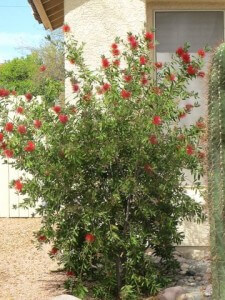Bottle Brush is the April Plant of the Month!
Callistemon citrinus, Lemon bottlebrush, Crimson bottlebrush, small- to medium-sized tree
The lemon bottlebrush is a good choice for smaller areas since it grows to twelve feet with a six- to nine-foot spread. Its evergreen leaves are narrow, leathery, and produce a citrus aroma. Bright red fuzzy, fragrant blossoms arranged on the stems in clusters appear in early spring and sporadically throughout the summer. Its distinctive blooms attract hummingbirds, birds, and bees. The plant is hardier than the weeping bottlebrush, withstanding temperatures down to twenty to twenty-five degrees Fahrenheit. It grows best in full sun and in well-draining, sandy, or loam soils, and it prefers to have its roots dry out between irrigations. Once established, it can tolerate drought and does not like to be over-watered. This tree is also susceptible to iron chlorosis and requires chelated iron fertilizer as needed, and an application of ammonium phosphate in the spring. Heavy, unnecessary pruning or hedging will reduce flowering. It is a relatively easy plant to grow as a specimen tree in a tropical setting, around a pool, as a patio tree, or against a pale wall. Plant it in an area that is somewhat protected but where it can be admired. This plant is native to Australia and New Zealand.
Callistemon viminalis, Weeping bottlebrush, medium- to large-sized tree
This beautiful, tropical evergreen with long weeping stems grows quickly to a height of thirty feet with a fifteen-foot spread. It forms a wide crown when the lower branches are pruned off. Its foliage is narrow and bronzy green in color, especially when new growth emerges in the spring. The leaves turn dark green as the spring foliage matures. In spring, the tree produces magnificent scarlet blossoms that contain brilliant red stamens resembling brushes. After the bloom cycle, it develops cup-like seed capsules that are distinctive to this genus. The weeping bottlebrush likes full sun, reflected heat, and well-draining soil. It prefers frequent irrigation but tolerates periods of drought once it is established. Young trees benefit from corrective staking to protect them from the wind. This plant is susceptible to frost at around twenty degrees Fahrenheit and does not like windy locations. Plant the weeping bottlebrush in lower desert locations to protect it from frost damage. Also, regularly treat it with chelated iron fertilizer to prevent iron chlorosis. Bottlebrush can be grown as a specimen tree along a wall or building. Its weeping appearance creates a nice silhouette against any background. Also consider using as a strong, vertical accent plant or screen, or plant it in masses at the edge of a pond or lake, creating a tropical effect. The bottlebrush is native to waterways in New SouthWales, Australia.






